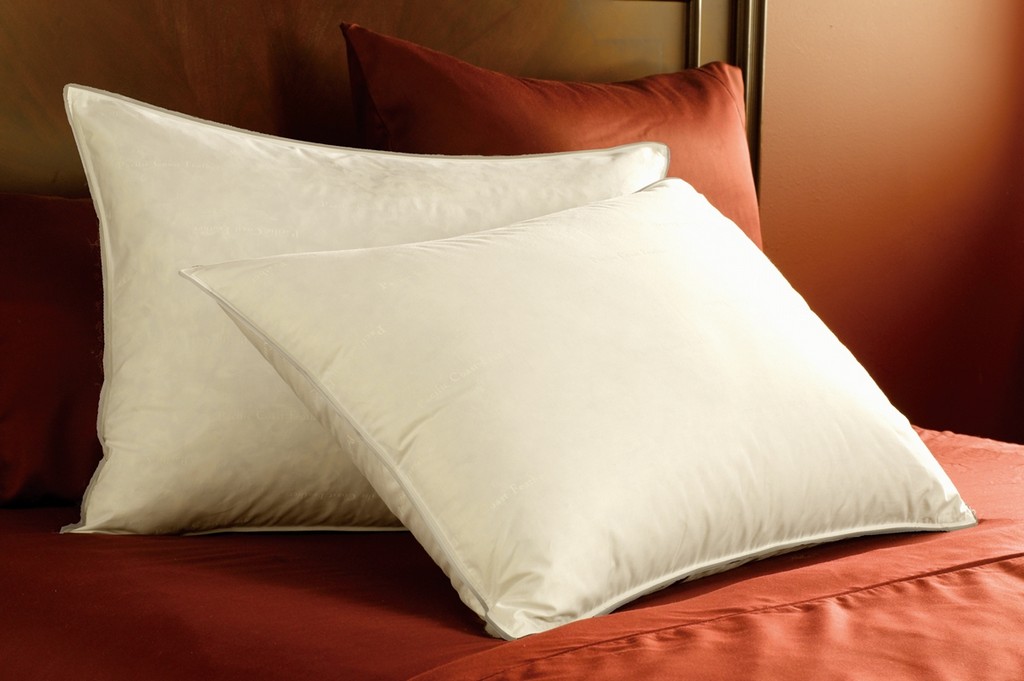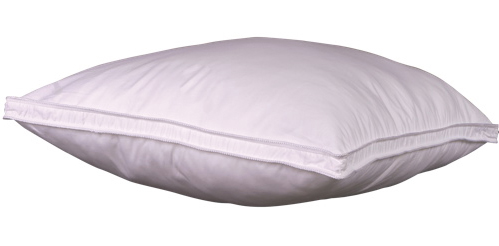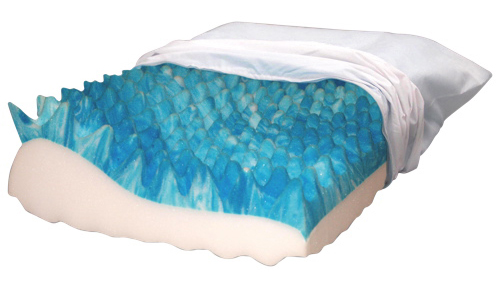 One morning last week, I woke up with such a terrible pain in my neck and shoulder that I thought I had been stabbed in my sleep. As soon as I realized that I watch far too many crime dramas on TV, I managed to wrench myself out of bed and get ready for the day ahead. Considering the fact that I had done nothing even remotely strenuous the day before, I figured there could only be one culprit responsible for my agony – my pillow. My pancake flat, ancient, misshapen pillow that I love ever so much. But as it turns out, buying a new pillow isn’t as easy as you’d think! There are a tone of options out there. Armed with my newfound knowledge, I thought I’d share with you the 411 on pillows.
One morning last week, I woke up with such a terrible pain in my neck and shoulder that I thought I had been stabbed in my sleep. As soon as I realized that I watch far too many crime dramas on TV, I managed to wrench myself out of bed and get ready for the day ahead. Considering the fact that I had done nothing even remotely strenuous the day before, I figured there could only be one culprit responsible for my agony – my pillow. My pancake flat, ancient, misshapen pillow that I love ever so much. But as it turns out, buying a new pillow isn’t as easy as you’d think! There are a tone of options out there. Armed with my newfound knowledge, I thought I’d share with you the 411 on pillows.
History of the pillow
It’s easy to take for granted items that we use everyday—like the pillow. But unlike today where a pillow’s primary purpose is to cradle your head in comfort for a good night’s sleep, the earliest historically recorded pillow was used in 7,000 BC in early Mesopotamia, and it was made of stone. I repeat, stone: a stone block with a half-moon cut out on the top on which one would rest their head. These “pillows” were not meant for comfort, but were used to keep one’s head off the ground and prevent bugs from entering their ears or making a new home in their hair.
The ancient Chinese also used hard materials for their pillows including stone, bronze, bamboo, and wood. But they decorated their pillows in ornate and elaborate decorations, so I guess that makes them better? Sure. Also in Asia, Japanese Geishas used smaller, yet similar, hard pillows to keep their heads off the ground at night and their intricately coiffed hair intact for days.
In Europe, the Ancient Greeks and Romans were more concerned with comfort and stuffed sacks with cotton, grass, reeds, and hay to make their pillows. Scratchy for sure, but these pillows are more closely related to the pillows we see on our beds today.
Pillow Types
Pillows today are a whole heck of a lot more comfortable than a chunk of stone or burlap sack full of hay, and tend to fall into one of three main categories:

- Down and feather pillows: As the name suggests, down pillows are filled with the fine feathers found on a baby bird or
beneath the outer feathers of an adult bird. Depending on the pillow, they could be stuffed with down, feathers, or a combination of the two. The great thing about down and feather pillows is that they are ridiculously soft and comfortable. These are the kind of pillows you want to curl up with every night as they mold perfectly to your shape. That said, they compress easily so need to be fluffed much more frequently than other pillow types.  Synthetic pillows: Synthetic pillows are typically filled with polyester and are often much less expensive than down or feather pillows. In fact, these are the kind of pillows you’ll see in bargain bins in warehouse stores. That doesn’t mean they aren’t a great option though—just do yourself a favour and avoid purchasing a pillow for $9. You spend at least a quarter of your life in your bed and your neck and back deserve more than a $9 investment! But I digress. The good thing about synthetic pillows is that they still offer a nice level of comfy-coziness and many, like this Simple & Pure Medium Polydown Pillow are machine washable. The bad though, is that the contents of synthetic pillows tend to shift and get lumpy over time, which is something that can’t be fixed, no matter how much fluffing you do.
Synthetic pillows: Synthetic pillows are typically filled with polyester and are often much less expensive than down or feather pillows. In fact, these are the kind of pillows you’ll see in bargain bins in warehouse stores. That doesn’t mean they aren’t a great option though—just do yourself a favour and avoid purchasing a pillow for $9. You spend at least a quarter of your life in your bed and your neck and back deserve more than a $9 investment! But I digress. The good thing about synthetic pillows is that they still offer a nice level of comfy-coziness and many, like this Simple & Pure Medium Polydown Pillow are machine washable. The bad though, is that the contents of synthetic pillows tend to shift and get lumpy over time, which is something that can’t be fixed, no matter how much fluffing you do.
 Foam pillows: Foam pillows have gained significantly in popularity over the last several years due in large part to the fact that both memory foam and natural latex foam mold themselves to the shape of your head and constantly adjust as you move during the night. So no matter how much you shift and twist in your sleep, your head, neck, and back are always perfectly supported. Plus, foam pillows don’t shift or clump like down and synthetic pillows do over time. One negative though is that because foam pillows trap body heat, they tend to get warm, which many people find to be a deal-breaker.
Foam pillows: Foam pillows have gained significantly in popularity over the last several years due in large part to the fact that both memory foam and natural latex foam mold themselves to the shape of your head and constantly adjust as you move during the night. So no matter how much you shift and twist in your sleep, your head, neck, and back are always perfectly supported. Plus, foam pillows don’t shift or clump like down and synthetic pillows do over time. One negative though is that because foam pillows trap body heat, they tend to get warm, which many people find to be a deal-breaker.
Pillow Styles
The types of pillows that are available is only half the equation. Once you’ve decided on synthetic, down, or memory foam, you need to determine which style is best for you and your particular needs. The right pillow will support your head and neck and keep your spine aligned in the correct position as you sleep.
- Back Sleepers: Back sleepers need good neck, head, and shoulder support at night, and should look for a pillow that supports that natural curvature of the spine like the BodyForm Orthopedic Nightwave Gel Infused Foam Pillow. This memory foam pillow is infused with polyurethane gel and offers a high level of firmness with full orthopedic support for a fantastic night’s sleep. It’s also not too thick, which is a bad thing for back sleepers as thick pillows may put your neck at an awkward angle.
- Side Sleepers: Unlike back sleepers, side sleepers need a less firm pillow. While standard medium firmness pillows will do the trick, there are actually specially designed “side sleeper” pillows out there, like the Vivon Standard Side Sleeper Pillow, that made room for your shoulder, so it isn’t in the way while you sleep – which, as a side sleeper myself, I know can be a real pain in the behind!
- Stomach Sleeper: Stomach sleepers should look at light support down pillows. This is so their head can sink into the pillow without undue pressure being put on the neck and spine.
- Pregnant Sleepers: Being pregnant comes with its share of highs and lows, but finding a comfortable position to sleep in definitely fits into the “low” bucket (although, I don’t have children, so am going on the word of my pregnant and parent friends here!). To alleviate back pain and help ensure a relatively good night’s sleep, I’ve been told body pillows are the bee’s knees and cradle you to sleep every night. Makes me wonder if you have to be pregnant to get one!
So there you have it folks, the 411 on pillows. If you are looking to replace or upgrade your existing pillow(s), first, determine what kind of sleeper you are – side, back, belly – and then determine which material best suits your needs and budget. Once you’ve selected a new pillow you’ll be on your way to a better sleep and a pain-free morning!
For a full selection of pillows available at BestBuy.ca, click here.



